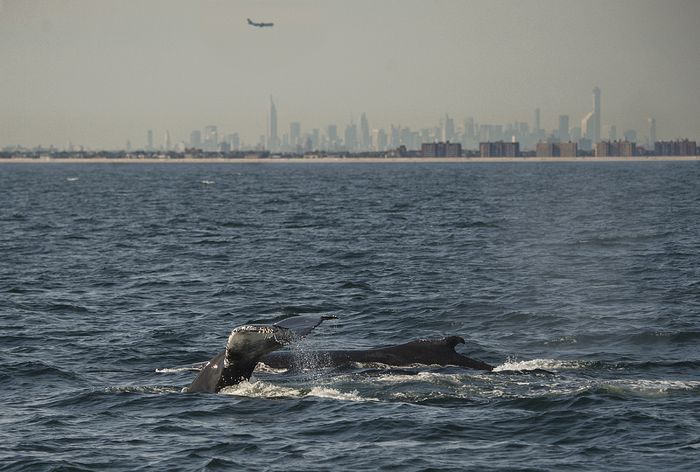A team of scientists used an emerging genetic tool that analyzes DNA in water samples to detect whales and dolphins in New York waters.

Credit: Julie Larsen Maher
A team of scientists used an emerging genetic tool that analyzes DNA in water samples to detect whales and dolphins in New York waters.
Called environmental DNA or eDNA, the technique searches for trace amounts of genetic material left behind by wildlife.
The scientists, from California State University, CUNY, Wildlife Conservation Society (WCS), and Columbia University, published their results in the journal Frontiers.
The scientists say that eDNA can be used to complement other methods to locate whales and dolphins such as visual observations and acoustic monitoring, and their eDNA detections are some of the most promising to date for detecting whales and dolphins from seawater in the open ocean.
Said the study’s lead author Dr. Elizabeth Alter of California State University: “Determining how cetaceans and other threatened marine animals use coastal habitats is critical to their effective conservation. By generating eDNA data in parallel with survey data, it will be possible to gain a clearer understanding of how this tool can be used in management and conservation contexts to monitor species of conservation concern over large marine ecosystems.”
In addition to finding whales and dolphins, the technique detected baitfish present in the area preyed on by whales and dolphins. The authors say the technique could eventually be used to identify individual animals.
Said Dr. Howard C. Rosenbaum, Director of WCS’s Ocean Giants Program/Senior Scientist NY Aquarium and a co-author of the study: “Innovation and application of new techniques, such as the possibility of using eDNA, that leads to having better information about distribution of whales, dolphins and their prey is so important today, especially where potential impacts in these habitats may be increasing human activities.”
The authors say that eDNA drops to lower levels over time and that additional research is needed to better understand how factors such as behavior and oceanographic conditions contribute to the longevity of eDNA signals.
Though there are some signs of promising recovery for many whale species and populations, whales continue to face a range of modern day threats ranging from ship strikes, to entanglement with nets, to ocean noise.
The Biden-Harris administration, New York State and other states on the eastern seaboard are scaling up massive renewable energy projects to meet energy demands and help address climate change, including a wind energy auction for more than 488,000 acres in the New York Bight. There are many potential impacts from these developments to whales that the environmental community, industry, and state/federal authorities are aiming to address. WCS has been involved at state and national level dialogues as well as developing best practice guidance through the IUCN.
The use of emerging and novel techniques such as eDNA as demonstrated by the results of the current study in the NY Bight and other approaches can offer new insights as to whale presence and their prey in and around lease areas as offshore wind scales up along the eastern seaboard. More broadly, WCS increasingly uses eDNA in its conservation work, detecting critically endangered wildlife such as Swinhoe’s softshell turtle, in the Bolivian Amazon, and in some of the most rugged areas on the planet including Mt. Everest.
To learn more about WCS’s work to protect whales in New York waters, visit https://whalesofnewyork.wcs.org/
###
WCS (Wildlife Conservation Society)
MISSION: WCS saves wildlife and wild places worldwide through science, conservation action, education, and inspiring people to value nature. To achieve our mission, WCS, based at the Bronx Zoo, harnesses the power of its Global Conservation Program in nearly 60 nations and in all the world’s oceans and its five wildlife parks in New York City, visited by 4 million people annually. WCS combines its expertise in the field, zoos, and aquarium to achieve its conservation mission. Visit: newsroom.wcs.org Follow: @WCSNewsroom. For more information: 347-840-1242.
Journal
Frontiers in Conservation Science
DOI
10.3389/fcosc.2022.820377
Method of Research
Randomized controlled/clinical trial
Subject of Research
Animals
Article Title
Using Environmental DNA to Detect Whales and Dolphins in the New York Bight
Article Publication Date
11-Feb-2022
COI Statement
The authors declare that the research was conducted in the absence of any commercial or financial relationships that could be construed as a potential conflict of interest.




